本文
Oze National Park Guide Book(英語版尾瀬ミニブック)
群馬県では、尾瀬を訪れる外国人旅行者の増加を受け、尾瀬に関する外国人旅行者向けパンフレット(英語)を製作しました。
パンフレットに使用した英語解説文は、観光庁の「地域観光資源の多言語解説整備支援事業」で作成しました。
このページにはパンフレットの一部を抜粋して掲載します。全文は以下のダウンロードファイルで確認してください。
This page is an excerpt from Oze National Park Guide Book.
To browse the full version,please download a PDF file from the following link.
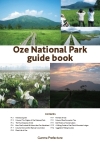
cover
Introducing Oze
Oze is the familiar name for the expansive area of mountains and marshland that makes up Oze National Park. It is located in the center of Japan’s largest island of Honshu, and straddles four prefectures: Gunma, Fukushima, Niigata, and Tochigi.
Oze’s natural environment shows little sign of human interference. Thanks to some of Japan’s strongest environmental protection programs, the area’s topography and wildlife have retained many physical and ecological characteristics that have developed over the millennia.
The marshlands of Oze, which are one Japan’s largest high moors, cover two basins, the western Ozegahara marsh and the Lake Ozenuma area to the east. The Ozegahara marsh covers an area 6 kilometers long and 2 kilometers wide, where the average altitude is 1,400 meters. Lake Ozenuma, which lies at an altitude of 1,660 meters, has a circumference of 9 kilometers. The plateau was formed after lava from volcanic eruptions some two million years ago created an independent depression. This gradually evolved into the peat moor that is now home to expansive fields of marsh plants, including a variety of colorful wildflowers.
The Ozegahara marsh is surrounded by mountains in the 2,000-meter range, with the highest, Mt. Hiuchi, reaching 2,356 meters. All but the peak of Mt. Shibutsu are volcanic in origin and covered in thick forest. Mt. Shibutsu’s mineral makeup is less compatible with plant growth, so it has a lower tree line than the other peaks, giving hikers panoramic views of the marshes spreading out to the east.
There are no roads in the national park. The only entrances to the park are forest trails from several mountain passes that lead up to the surrounding mountain peaks or down to the marsh area. The Hatomachi-toge Pass on the Gunma Prefecture side of the park is the most popular entrance. The hiking trails in the mountains are clearly marked and well maintained, as are the protective boardwalks that crisscross the marshland. The routes are varied, from courses that can be covered on a day trip to longer routes that require staying overnight in the park.
Oze National Park is open from early May to late October. Even over this relatively short season, Oze shows many different faces, as the altitude and weather patterns result in constantly changing conditions. Watching the early morning fog over the peat moors slowly lift to reveal the silhouette of the surrounding mountains is an unforgettable experience. Rainbows occur often, and sunny days can quickly turn cloudy, and vice versa. Many visitors are enthusiastic photographers, who come to capture Oze in its many manifestations.
The park is closed in the winter due to massive amounts of snow and bitter cold temperatures that reach as low as -10°C. Because of the high altitude, summer temperatures rarely reach 30°C, and nights can become quite chilly.
There are two Visitor Centers where knowledgeable staff are on hand to help guests learn about the park, its natural environment, animal life, and other characteristics. They can also help with practical and logistical advice about the mountain trails, boardwalk routes, and recommended clothing and equipment. There are three campsites and over 20 lodges around the park, offering accommodation, meals, and hot baths for hikers.
For many years, Oze has been the focus of preservation efforts by conservation activists, mountain lodge operators, park administrators, and, of course, visitors. The national park continues to protect the environment while sharing its natural beauty with visitors.
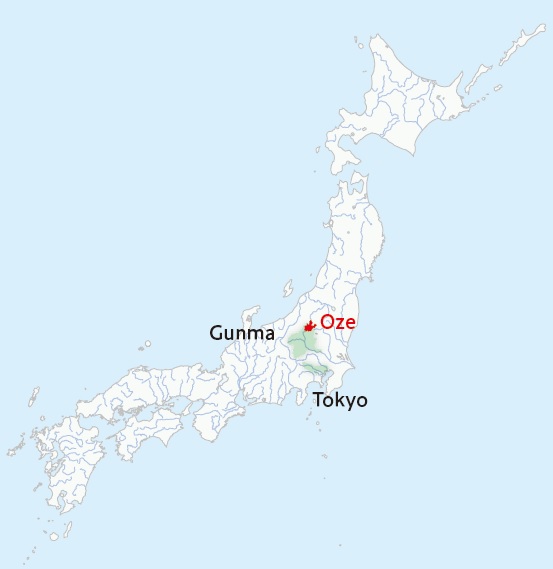
Map
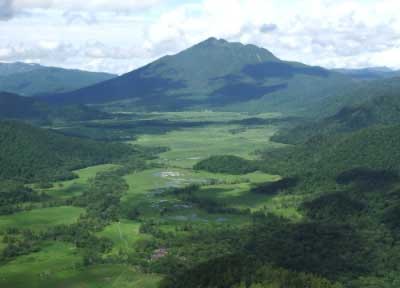
The View from the top of Mt.shibutsu
The Four Seasons of Oze
The seasons in Oze are distinct, and many repeat visitors come at different times of the year in order to experience its seasonal highlights.
Spring
Spring comes late in Oze, with the snow beginning to melt in early May. The Visitor Centers begin operations, and the mountain huts are dug out from under the snow and start accepting visitors. Late May to mid-June is the season of the mizubasho, or Asian skunk cabbage, which brightens the marshes with its white flowers, attracting large numbers of visitors. Later, marsh marigolds add their golden yellow hues to the landscape.
Summer
The summer season is when the mountains are most accessible and the basins most verdant. In July the marshes turn white with the fluff of cottonsedge (eriophorum), then shift to bright yellow when the day lilies bloom later in the month. This is the peak of Oze’s floral (and tourist) season. Hikers come to climb the many peaks and casual visitors come to enjoy the scenery from the boardwalks that traverse the marshes.
Autumn
The climate turns cooler in late August as autumn comes to Oze, and animals begin preparing for a long winter hibernation. The foliage begins to change color in September, when the marsh grasses and other vegetation turn to autumn gold. Later in the month, trees on the mountainsides like maple and beech turn bright red, yellow and brown. Snow begins to fall in October, and by November has accumulated into deep drifts, making the park largely inaccessible until spring.
Winter
The snowfalls that begin in mid-October eventually turn all of Oze into deep snow country. The park staff and mountain huts prepare the facilities to survive the elements, then leave for the winter period. The snow layer, which can reach depths of 3 to 4 meters in parts of the park, plays a big part in maintaining the Oze’s ecosystem, protecting the plants from the bitter winds of mid-winter and nourishing the growth of new sprouts as snowmelt in late spring.
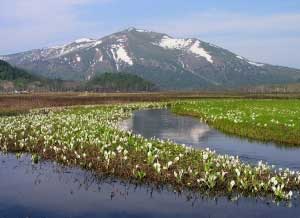
Spring
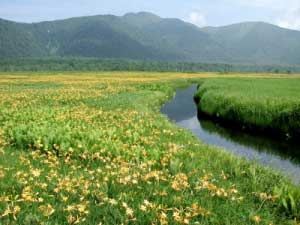
Summer
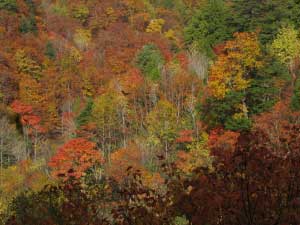
Autumn
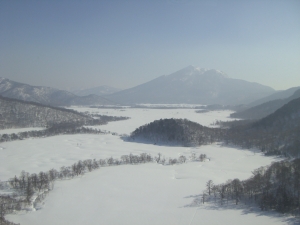
Winter
A Hiking Guide to Oze
Oze has well-maintained hiking courses for every class of hiker, from the level boardwalks that crisscross the marshlands to steep mountain trails that reach high above the tree line. Hikers should keep in mind that the weather can be very unpredictable, due to the ring of surrounding mountains. A perfectly clear, warm morning can turn misty and cold by afternoon, and vice versa. Visitors are encouraged to wear appropriate clothing that is comfortable, and bring rain gear and extra layers.
WHAT TO WEAR
Hat
Solar rays are strong at high altitudes, so a hat with a brim is recommended.
Underwear or base layer
Light synthetic or wool fabric that will dry quickly.
Long-sleeved shirt
Quick-drying materials recommended.
Socks and shoes
Thick socks and comfortable yet sturdy walking shoes. For mountain trails, high-cut hiking boots.
Backpack
Size depends on length of hike and tent use. A rain cover is recommended.
Hiking pants
Lightweight synthetic, long pants, or shorts over tights.
WHAT TO CARRY
Warm layer (fleece, down, or synthetic fabric shirt)
Waterproof jacket and pants
Drinking water
Garbage bag
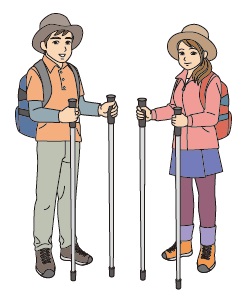
Wear
Oze’s Mountain Lodges
There are over 20 mountain lodges (yamagoya) in Oze National Park, offering accommodation for hikers with two full meals and hot baths. Visitors should be aware that meals are served early, because Japanese hikers tend to arrive by mid-afternoon and make early starts in the morning. Breakfast is usually served at 6:00 A.M., with the evening meal at 5:00 or 5:30 P.M. These lodges have been operated by the same families for generations and the staff are founts of knowledge about Oze’s history, nature, and other aspects of the park. They help maintain the trails as well and can update visitors on hiking and weather conditions. All the lodges follow strong conservation protocols, including toilet systems that do not pollute the water table. Guests are asked to cooperate with these efforts, including carrying out any garbage they brought in.
Staying at one of the lodges for a night or two gives hikers a deeper experience and appreciation for Oze’s wild natural environment. During golden hour, the early evening sun bathes the area in a warm light, and the air cools quickly after sunset. With little light pollution, Oze is one of Japan’s best sites for viewing the night sky. Early risers can enjoy the fog banks that cover the marshes, slowly rising to unveil the mountains around the plateau.
Note that the lodges can get crowded, particularly in peak seasons, so reservations should be made well in advance.
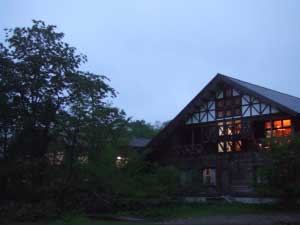
Oze's Mountain Lodges
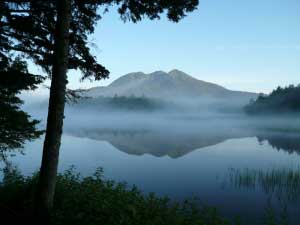
Lake Ozenuma
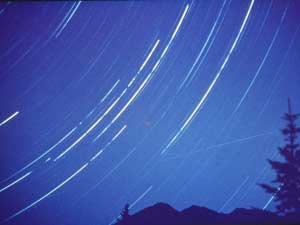
Starry sky
Suggested Hiking Courses
Hikers can plan their own routes using the trails that crisscross the park, through marshes and mountain forests. These are two sample courses, a one-day hike around the marshes, and a two-day hike that includes climbing Mt. Shibutsu.
Sample Course 1
Woodland Wonders and High-altitude Marshlands
A beginner-friendly descent through mountain forests to the marsh plateau and back, offering splendid views of the valley
Route: Hatomachi-toge Pass – Yamanohana – Ryugu-jujiro Crossroad – Yoppi Suspension Bridge – Hatomachi-toge Pass
Total time: 6 hours
Level: Easy
Details
This hike is mostly downhill or over flat boardwalks, except for the final ascent back up to the park’s entrance. The first hour is a descent to Yamanohana, where hikers will find a Visitor Center, lodges, and a campsite. From there, the trail leads across the broad, open expanse of the marshes, with great views of the surrounding mountains, ponds, and seasonal marsh flowers. Every so often, there are rest areas, wooden platforms with benches where people may eat or rest their legs. This course follows a circular route around the marshes, but can be shortened by turning back at the Ryugu-jujiro crossroad.
Sample Course 2
Up the Serpentinite Trail
For experienced hikers, this two-day course features a steep ascent of Mt. Shibutsu, for panoramic views in all directions.
Route: Hatomachi-toge Pass – Yamanohana – Marsh walks – Mt. Shibutsu – Hatomachi-toge Pass
Total time: 2 days (6 hours per day)
Level: Easy (Day 1); Hard (Day 2)
Details
The first day follows the same itinerary as the first sample course. Be sure to reserve accommodation at one of the lodges in Yamanohana or the Ryugu-jujiro crossroad. On the second day, get up early and take the trailhead at Yamanohana. The trail climbs steeply through the forest before rising above the tree line. Note that the serpentinite rock underfoot can be very slippery, particularly when wet, and the wind can be strong. From Mt. Shibutsu, hikers will get open views of the marshes on the plateau and the volcanic mountains surrounding the area. The descent follows the ridge route down to Hatomachi-toge Pass.
Cource Map(External link:Oze Preservation Foundation)<外部リンク>
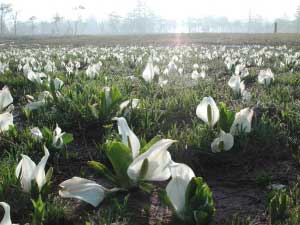
Mizubasho/Asian skunk cabbage
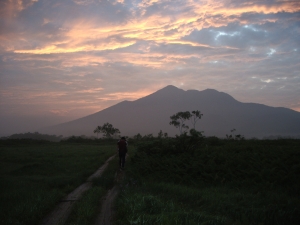
Sunrise
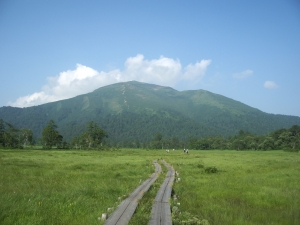
Mt.Shibutsu
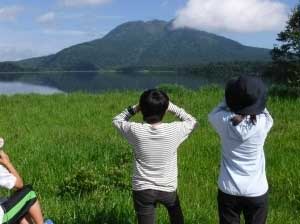
Lake Ozenuma
How You can Help
All visitors can contribute to preserving Oze’s natural environment.
Stay on the Paths
The boardwalks and hiking paths have been built to protect the park’s wildlife and natural environment from damage. Hundreds of thousands of visitors come to Oze each year, and we need everyone’s cooperation.
Take Everything You Bring to the Park Home with You
A single piece of litter can affect the park’s fragile environment. Take all the pictures you want but be sure to leave the park with all your garbage.
Water Quality Is Everyone’s Business
Water is a precious resource in Oze. Don’t use soap or shampoo at the campsites or in the mountain hut’s baths.
Think of Others
Oze is a place to get back to nature. Let others experience the natural sights and sounds without disturbances.
If You Need Help . . .
The staff at the Visitor Centers can answer questions and provide information to park guests. Feel free to drop by and share your feedback.








